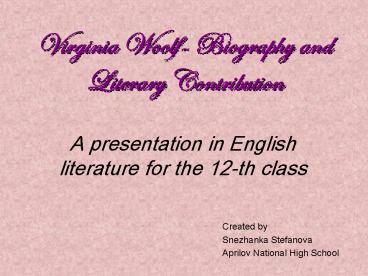Virginia Woolf Biography and Literary Contribution PowerPoint PPT Presentation
1 / 12
Title: Virginia Woolf Biography and Literary Contribution
1
Virginia Woolf- Biography and Literary
Contribution
- A presentation in English literature for the
12-th class
Created by Snezhanka Stefanova Aprilov National
High School
2
Virginia Woolf/1882-1941/
- Virginia Woolf was a British novelist regarded
as one of the foremost modernist literary figures
of the twentieth century. Her stream-of-consciousn
ess technique and poetic style are among the most
important contributions to the modern novel.
3
Biography
- Born Adeline Virginia Stephen in London to Sir
Leslie Stephen and Julia Prinsep Duckworth (née
Jackson) (18461895), she was educated by her
parents in their literate and well-connected
household at 22 Hyde Park Gate, Kensington.
Virginia's parents had married each other after
being widowed and the household contained the
children of three marriages. - Sir Leslie Stephen's eminence as an editor,
critic, and biographer, and his connection to
William Thackeray (he was the widower of
Thackeray's eldest daughter) meant that Woolf was
raised in an environment filled with the
influences of Victorian literary society. - The sudden death of her father, when Virginia was
14, and that of her sister Stella 2 years later,
led to the first of Virginias nervous
breakdowns. - The death of her father in 1904 provoked her most
alarming collapse and she was briefly
institutionalised.
4
- Although she was married to Leonard Woolf from
1912 until her death in 1941, some of Virginias
strongest romantic ties were with women. - In 1917 with her husband she founded the Hogarth
Press which became the first to publish Sigmund
Freud in English (this greatly inspired Woolf).
The Hogarth Press also published T.S.Eliot,
Katherine Mansfield, Maxim Gorky and all Woolf's
writings. - 1941 At the onset of another mental breakdown,
which she feared would be permanent, Virginia
Woolf filled her pockets with stones and drowned
herself in the River Ouse near her home leaving
the following suicide note for her husband and
sister.
5
Suicide note to her husband, Leonard Sidney
Woolf (18 March 1941)
- Dearest, I feel certain I am going mad again. I
feel we can't go through another of these
terrible times. And I shan't recover this time. I
begin to hear voices, and can't concentrate. So I
am doing what seems the best thing to do. You
have given me the greatest possible happiness.
You have been in every way all that anyone could
be. I don't think two people could have been
happier till this terrible disease came. I can't
fight any longer, I know that I am spoiling your
life, that without me you could work. And you
will I know. You see I can't even write this
properly. I can't read. What I want to say is I
owe all the happiness of my life to you. You have
been entirely patient with me and incredibly
good. I want to say that everybody knows it. If
anybody could have saved me it would have been
you. Everything has gone from me but the
certainty of your goodness. I can't go on
spoiling your life any longer. I don't think two
people could have been happier than we have been.
6
Places of Artistic Inspiration
"Probably nothing we had as children was quite so
important to us as our summers in Cornwallto
hear the waves breakingto dig in the sands to
scramble over the rocks and see the anemones
flourishing their antennae in the pools"
The area around St. Ives was a fruitful childhood
haunt for the young Virginia. The far-off vision
of the Godrevy lighthouse was to come back to her
as a potent literary motif in later life.
7
Decorated in the Bloomsbury style, its preserved
interior is a unique example of Vanessa Bell and
Duncan Grant's distinctive style of decorative
art in a domestic context and is the fruition of
over 60 years of artistic creativity.
The interior of the house is preserved just the
way it was. Everywhere you look there is art,
even in the bathroom.
Charleston in Firle, East Sussex has become a
Mecca for anyone interested in Virginia Woolf and
the Bloomsbury set. It was acquired by Virginia's
sister, Vanessa, in 1916, and became a home and
meeting place for some of the most influential
artists and thinkers of the day.
8
1940 The Woolfs London home in Meckleburgh
Square was bombed in August 1940 and their
country home, Monks House in Rodmell, East
Sussex, became their permanent residence. It is
now a National Trust property and its preserved
rooms effectively reflect the life and times of
Virginia Woolf and her circle.
Sissinghurst, Vita Sackville West's house and
garden creation is home to the first printing
press used by Woolf in the early days of the
Hogarth Press.
9
Literary Work and Contribution
- Virginia Woolf is considered one of the greatest
innovators of the English language. In the words
of E.M. Foster, she pushed the English
language a little further against the dark ,and
her literary achievements and creativity are
influential even today. Woolf is the major
lyrical novelist in the English language. Her
novels are highly experimental a narrative,
frequently uneventful and commonplace, is
refractedand sometimes almost dissolvedin the
characters' receptive consciousnesses. Intense
lyricism and stylistic virtuosity fuse to create
a world overabundant with auditory and visual
impressions.
- 1905 Virginia began writing professionally for
the Times Literary Supplement. At the same time
she and her sister and brothers established a
household in the Bloomsbury section of London,
which became a gathering place for members of the
London intelligentsia.Between the World Wars the
Bloomsbury group inspired the trends and ideas in
modern, 20-th century thinking, philosophy and
art.
10
Stream of Consciousness /Interior Monologue/
11
(No Transcript)
12
The End

